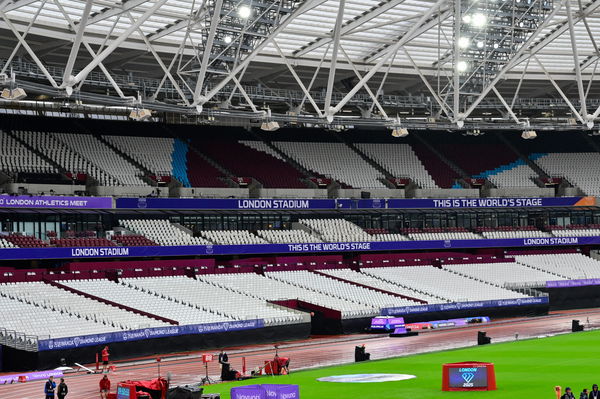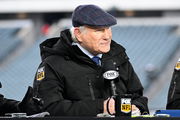
Imago
Image Via Imago

Imago
Image Via Imago
The men who chase the decathlon crown and the women who contest the heptathlon still carry a ceremonial label: “world’s greatest athlete.” Yet for all the mythology attached to that title, the compensation for track stars remains starkly out of proportion. At the recent U.S. Olympic Trials in 20244, Zach Ziemek ran unattached, without a sponsor, despite being a two-time Olympian and World Championship medalist. He collapsed at the finish of his 1500 meters, spent from the effort, but there was no brand logo stitched across his chest. “It was confirmation of what a long term investment in a guy is,” his coach said, but the financial system in place has invested very little.
Watch What’s Trending Now!
The gap between glory and livelihood is not new. American Olympians have always wrestled with money. Many still work full-time jobs, while federations and Olympic committees negotiate billion-dollar television contracts. A select few—Noah Lyles, Sha’Carri Richardson, Katie Ledecky—command endorsement deals worth millions, but the “athletic middle class” is left to scrape by on modest grants or irregular sponsorships. “Everybody is sort of left to their own devices to either find sponsorships or get a job,” explains Han Xiao, co-chair of the Commission on the State of US Olympics & Paralympics.
The more troubling reality becomes clear when measured against inflation. And a comparison done by Olympic medalist and track and field expert Rori Dunk on his X post (@FitzDunk) unravels the truth. The prize money awarded at World Championships has only slightly shifted in a decade, even as the cost of living has undergone a massive surge. In 2015, the gold medal payout stood at $60,000. In 2025, a gold medalist in Tokyo will receive only slightly more, $70,000. Adjusted for inflation, that figure should now stand at $81,778, per Rori Dunk. Silver, still fixed at $35,000, would be worth $40,889 if it had kept pace. Bronze should have risen from $22,000 to $27,259.
ADVERTISEMENT
Instead, the entire scale of pay in the World Championship has stagnated: fourth place remains $16,000 instead of $20,444, fifth $11,000 instead of $13,629, sixth $7,000 instead of $8,177, seventh $6,000 instead of $6,814, and eighth $5,000 instead of $5,451. The arithmetic leaves every finalist effectively earning just slightly more than those who had won a decade ago.
What it should be in 2025 based on what it was in 10 years
🥇$81,778
🥈 40,889
🥉 $27,259
4. $20,444
5. $13,629
6. $8,177
7. $6,814
8. $5,451— RoriDunk (@FitzDunk) August 23, 2025
The economic environment in that span underscores the gap. From 2015 through 2020, global inflation averaged between 3 and 4 percent annually, before spiking in 2021 and 2022. That surge reached 8.00 percent globally in 2022 and 8.0 percent in the United States, the highest in four decades. Housing, food, and travel costs accelerated, all of which directly affect athletes whose sport demands constant mobility. By 2024, inflation had cooled but remained above pre-pandemic levels. In other sectors, wages and appearance fees rose to absorb these pressures. In athletics, championship prize money did not move.
ADVERTISEMENT
The imbalance has grown sharper as sports marketing narrowed its scope. Nearly all finalists in sprinting and middle-distance events at this year’s Trials had shoe or apparel deals. In the decathlon and heptathlon, fewer than half did. About half of all Olympic and Paralympic hopefuls in the United States report never having received any sport-related compensation, while more than a quarter survive on less than $15,000 per year. Grants from USATF or the USOPC range between $10,000 and $40,000 but are typically reserved for proven champions, not rising competitors. That leaves many caught between training at an elite level and maintaining part-time work simply to meet basic expenses.
In the 1990s, a partnership with VISA once offered decathletes stipends, travel allowances, and performance bonuses. That era has long ended. Today’s prize purses lag behind inflation, and the broader support system remains patchy. Ziemek’s generation proves that the pursuit of mastery continues, but the financial architecture around the sport has not kept pace with either the economy or the ideals of the Games themselves. The title of “world’s greatest athlete” has endured. However, the compensation for World Championship track athletes has not. Adding to this, athletes across track and field endured mounting frustration as prize money delays exposed the sport’s fragile payment system.
ADVERTISEMENT
Why Athletes Keep Waiting as Track Meets Fail to Deliver Prize Money on Time
Athletes had begun to question why their prize money, earned months earlier on the track, had still not arrived in their accounts. Grand Slam Track, which once promoted itself as a transformative league, became the center of this concern after reports from Forbes revealed that nearly $13 million in appearance fees and winnings had remained unpaid. The delay stretched well beyond what athletes normally tolerated, leaving many to wonder why the simplest expectation, timely compensation, had turned into a protracted ordeal.

Imago
London Diamond League Athletics, London, UK – 19 July 2025 A general view of the stadium before the Diamond League Athletics meeting at The London Stadium, London on 19 July 2025 London London Stadium London England Copyright: xAlanxStanford/PPAUKx PPA-198188
One explanation often cited in the sport had been the time required for anti-doping clearance, since no athlete could be paid until testing confirmed eligibility. Yet that process typically spanned weeks, not months. As Paul Doyle explained, holding the majority of competitors while only a small fraction underwent testing created unnecessary bottlenecks. “I don’t think it’s a good policy,” he said, noting that most athletes cleared without incident. Even so, those standard lags paled beside the months-long silence that surrounded Grand Slam Track.
ADVERTISEMENT
The deeper problem appeared financial. Olympic legend Michael Johnson admitted the league had experienced “major cash flow issues” after a significant investment fell apart. For athletes, however, that acknowledgement did little to soften the reality of waiting 128 days after Kingston, 100 after Miami, and 73 after Philadelphia. The sums withheld were not minor, and unlike isolated disputes in the past, the scale of this delay carried weight across the professional ranks.
Top Stories
Forced to Leave FOX, Cowboys Legend Troy Aikman Says ESPN Is Like ‘U.S. Government’ & Clearly Distinguishes the Two Networks

Who Is Paige Shiver? All About Michigan Football Staffer & Daughter of Veteran Bears Scout Jeff Shiver

FOX Issues Strict Ban on Terry Bradshaw But NFL Legend Defies It to Join Popular Morning Show

Michael Jordan Brings NASCAR to Its Knees as Jim France’s Courtroom Collapse Triggers Settlement

What Happened to T.J. Watt? Why Is He Hospitalized? Steelers Announce Latest News on LB Before Dolphins Game

LIV Golf to Cut Ties With Veteran Pro After His PGA Tour Return Intentions Became Public

Agents suggested that stricter penalties might be the only way to compel compliance. One remarked simply, “There should be consequences. Maybe you lose your status, a certain World Athletics label if you’re gold or silver or bronze.” In the absence of enforcement, the very individuals who sustained the competitions, the athletes, were left to shoulder the uncertainty of whether their earnings would ever arrive.
ADVERTISEMENT
ADVERTISEMENT
ADVERTISEMENT
ADVERTISEMENT

